MikroTik
 | |
| Limited company | |
| Industry | Networking hardware |
| Founded | 1996 |
| Headquarters | Riga, Latvia |
Key people |
John Tully, CEO and Arnis Riekstins, CTO |
| Products | Routers, firewalls, RouterOS |
| Revenue | 202.39 million Euros (2015)[1] |
| 61.37 million Euros (2015)[1] | |
Number of employees | 160 [2] |
| Website | www.mikrotik.com |

Mikrotīkls SIA, known internationally as MikroTik, is a Latvian manufacturer of computer networking equipment. It sells wireless products and routers. The company was founded in 1996,[3] with the intent to sell in the emerging wireless technology market. As of 2015, the company has more than 160 employees.[2]
RouterOS
The main product of MikroTik is an operating system based on the Linux kernel, known as the MikroTik RouterOS. Installed on the company's proprietary hardware (RouterBOARD series), or on standard x86-based computers, it turns a computer into a network router and implements various additional features, such as firewalling, virtual private network (VPN) service and client,[4] bandwidth shaping and quality of service, wireless access point functions and other commonly used features when interconnecting networks. The system is also able to serve as a captive-portal-based hotspot system.
The operating system is licensed in increasing service levels, each releasing more of the available RouterOS features. A MS Windows application called Winbox provides a graphical user interface for the RouterOS configuration and monitoring, but RouterOS also allows access via FTP, telnet, and secure shell (SSH). An application programming interface is available for direct access from applications for management and monitoring.
Features
RouterOS supports many applications used by Internet service providers, for example OSPF, BGP, Multiprotocol Label Switching (VPLS/MPLS), OpenFlow. The product is supported by Mikrotik through a forum and a wiki, providing assorted and thematic examples of configurations. RouterOS supports Internet Protocol Version 4 (IPv4) as well as Internet Protocol Version 6 (IPv6).
The software provides support for virtually all network interfaces that the Linux kernel 3.3.5 supports, except wireless, where the Atheros chipsets are the only supported hardware, as of RouterOS version 6.33.
Release history
- RouterOS version 6: May 2013[5]
- RouterOS version 6.38 (December 30, 2016)
- RouterOS version 5: March 2010
- RouterOS version 4: October 2009
- RouterOS version 3: January 2008
RouterBOARD
The company manufactures a series of integrated circuit boards, marketed under the name RouterBOARD, as well as accessory components which implement a complete hardware operating platform for RouterOS.
The RouterBOARD line, combined with RouterOS, is marketed at small- to medium-sized wireless Internet service providers, typically providing broadband wireless access in remote areas. Products include pre-assembled small office/home office (SOHO) routers, wireless 802.11a/b/g/n/ac MIMO and TDMA devices for indoor and outdoor use, and also bare routers in form of printed circuit boards (PCBs) for integration into custom solutions. Also, the RouterBOARD line includes a series of Mini PCI and Mini PCI Express wireless adapters, supporting a range of IEEE 802.11 protocols, and designed to be used together with the router boards lineup.
Some RouterBOARD boards and their versions are supported by third-party Linux-based firmware, notably OpenWrt.[6][7][8][9][10]

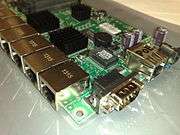 Close-up of a RouterBOARD RB493G (one RS-232 port, nine gigabit Ethernet ports)
Close-up of a RouterBOARD RB493G (one RS-232 port, nine gigabit Ethernet ports)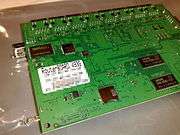
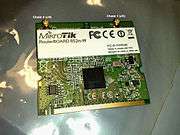
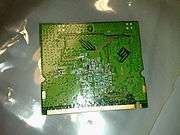 Bottom side of a RouterBOARD R52n-M
Bottom side of a RouterBOARD R52n-M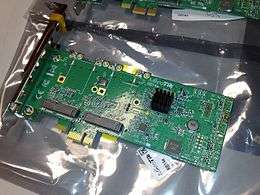 Top side of a RouterBOARD RB14e (PCIe ×1 card with a PCIe switch that allows up to Mini PCIe cards to be used in a single slot)[14]
Top side of a RouterBOARD RB14e (PCIe ×1 card with a PCIe switch that allows up to Mini PCIe cards to be used in a single slot)[14] Bottom side of a RouterBOARD RB14e
Bottom side of a RouterBOARD RB14e
Cloud Core Router
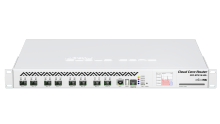
In November 2012, MikroTik released the Cloud Core Router integrated unit which is based on the Tilera CPU supporting nine to 72 CPU cores, 8 SFP+ (MiniGBIC) interfaces, as well as "fast-path" packet forwarding between interfaces (with independently tested 119 million packets and 80 Gbit/s forwarding rate[15]). This unit targets the medium-sized network providers as well as try to be a well priced alternative to the other more well-known brands.
MikroTik User Meeting (MUM)
The MUM is a conference and exhibition about networking, more targeted at MikroTik device users. Started as a regular gathering of forum users in January 2006, the events are now taking place every few weeks around the world, gathering hundreds of people at every event. The biggest event As of November 2015 was in Yogyakarta, Indonesia, gathering 2650 people.[16]
Use in developing IT markets
In 2004, a project began to build low-cost Internet infrastructure in rural Mali. MikroTik routers and their operating system were chosen because of their low cost, flexibility, the fact that the system already had "a substantial user base in Mali", and had a user interface deemed "superior to other products".[17] MikroTik routers were also preferred for a WLAN project in Burkina Faso,[18] and MikroTik's proprietary Nstreme protocol performed better than IEEE 802.11 under the project's conditions.[19]
In 2008, the Municipality of Piripiri, Piauí State, Brazil, decided to use MikroTik routers exclusively to build the infrastructure for providing free Internet access.[20] MikroTik routers are also popular in the Czech Republic and Hungary, where they enjoy a good reputation.[21]
Under OLPC program, Uruguay deployed a nationwide wireless network in schools. Probably the largest Mikrotik deployment in a country with a total population of 3 million. Approximately 200,000 students received a small laptop which connected to Mikrotik access points.
Vulnerabilities
On June 15, 2015, Brian Krebs, an online reporter, reported that "recently, researchers at the Fujitsu Security Operations Center in Warrington, UK began tracking [the] Upatre [trojan software] being served from hundreds of compromised home routers – particularly routers powered by MikroTik and Ubiquiti’s AirOS."[22]
References
- 1 2 "Pērn Mikrotīkla peļņa palielinājusies līdz 61,37 milj.EUR". Lursoft. 2016.
- 1 2 "MikroTik User Meeting Canada 2015" (PDF). mikrotik.com. 2015.
- ↑ "MikroTik Routers and Wireless: About MikroTik". mikrotik.com. Retrieved 19 November 2015.
- ↑ "Setup secure VPN access between client and server".
- ↑ MikroTik RouterOS: What's new in 6.0 (2013-May-17 14:04)
- ↑ "OpenWrt: Mikrotik Routerboard RB493G". OpenWrt. 2013-06-24. Retrieved 2013-09-27.
- ↑ "OpenWrt Forum: OpenWRT adapted to fully support RB493G (including SD)". OpenWrt. 2013. Retrieved 2013-09-27.
- ↑ "OpenWRT on Mikrotik Routerboard 411/750". poettner.de. 2011-05-27. Retrieved 2013-09-27.
- ↑ "Routerboard 450G and Linux". nexlab.it. 2009-04-12. Retrieved 2013-10-16.
- ↑ "RB500 Linux SDK". mikrotik.com. 2008. Retrieved 2013-10-16.
- ↑ OpenWrt: Mikrotik Routerboard RB493G June 2013
- ↑ RouterBoard: RouterBOARD 493/AH/G User's Manual (PDF), September 2011
- ↑ RouterBoard: RouterBOARD R52n-M: 802.11a/b/g/n dual band miniPCI card (PDF)
- ↑ RouterBoard: RB14e adapter card (PDF), October 2013
- ↑ "Stubarea Blog". Retrieved November 2015. Check date values in:
|access-date=(help) - ↑ "MUM webpage". MikroTik. 2015. Retrieved November 2015. Check date values in:
|access-date=(help) - ↑ Flickenger, Rob; et al. (December 2007). Wireless Networking in the Developing World: A practical guide to planning and building low-cost telecommunications infrastructure (PDF). wndw.net (2nd ed.). p. 321. OCLC 227819886. Retrieved 19 November 2008.
- ↑ Langobardi, Federico (2007). BoulSat Project: Radio network implementation by low cost technology (PDF). Master's Thesis, Politecnico di Torino. p. 78.
- ↑ Bartalesi, R.; Catusian, S; Langobardi, F. (8 August 2007). "Radio Network Implementation by Low Cost Technology: a Case of Study" (PDF). Pisa: Ingegneria Senza Frontiere, University of Pisa. pp. 3–4. Retrieved 19 November 2008.
- ↑ Filho, Paiva (16 October 2008). "Secretário fala da implantação da internet grátis". meionorte.com (in Portuguese). Jornal Meio Norte. Retrieved 19 November 2008.
Diga-se de passagem, o que há de mais moderno em equipamentos para este seguimento, onde utilizaremos os rádios da Mikrotik.
- ↑ Štrauch, Adam (7 November 2008). "Mikrotik: seznámení s Wi-Fi krabičkou". Root.cz (in Czech). Retrieved 19 November 2008.
Mikrotiky jsou velmi populární u poskytovatelů bezdrátového připojení a ohlasy od uživatelů jsou většinu kladné.
- ↑ "Crooks Use Hacked Routers to Aid Cyberheists".
External links
| Wikimedia Commons has media related to MikroTik. |
- Official website
- RouterBOARD home page
- Official user forum
- MikroTik Wiki
- MikroTik User Meeting (MUM)
- Official YouTube channel
- Want Wireless Broadband Today? Try a WISP
- Enabling OpenFlow v1.0 on Mikrotik RouterBoard 750GL: A Tutorial, 31 October 2014, by Uzzam Javed and Azeem Iqbal
- Enable Google Safe Search With Mikrotik RouterOS